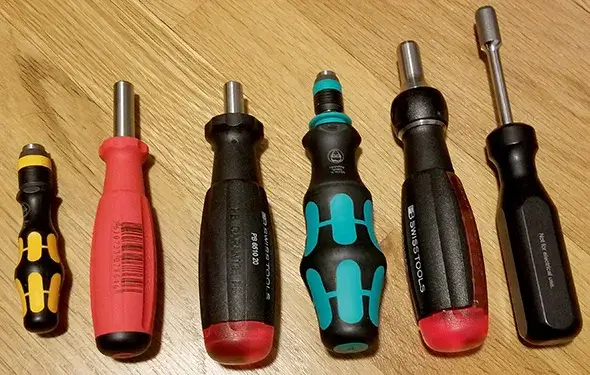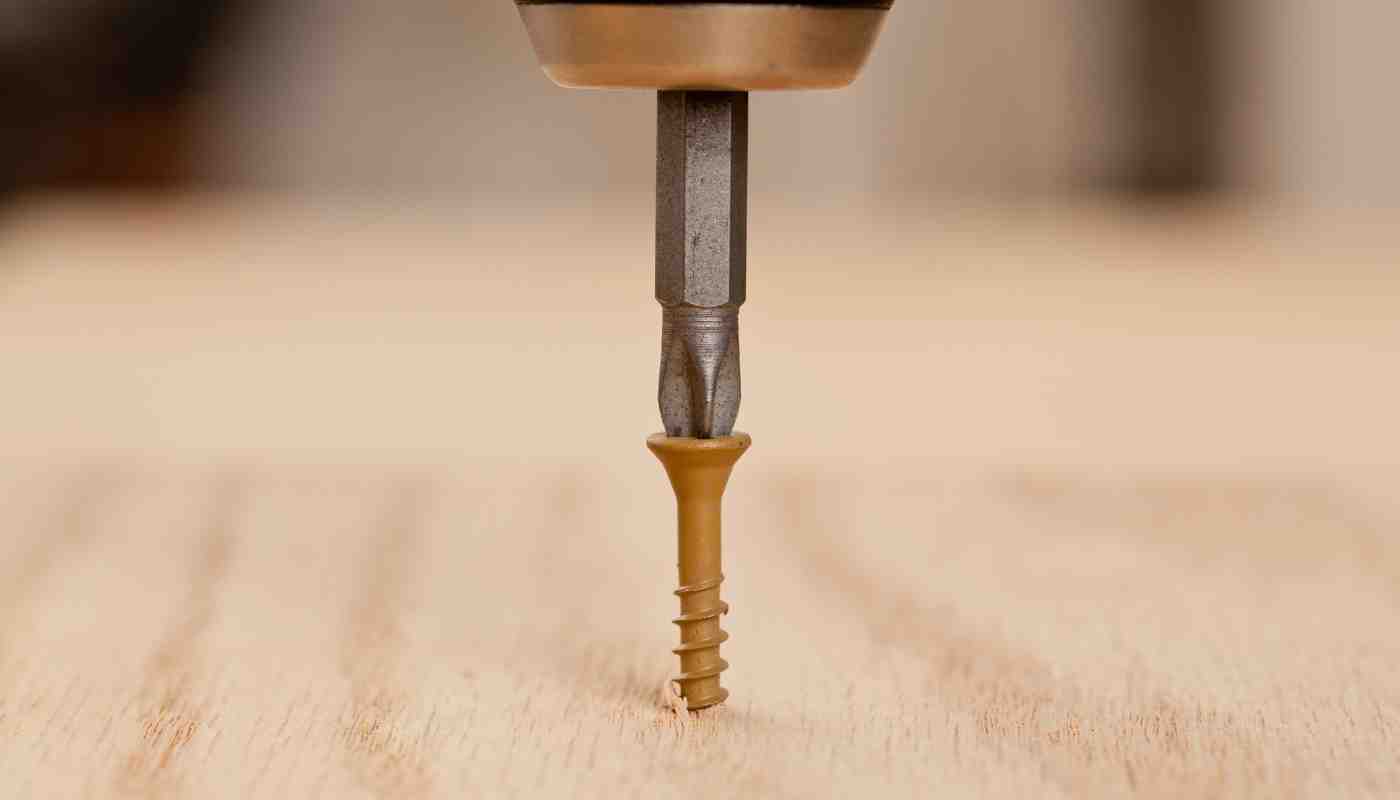Do you know how to screw into wood without drill? Most seasoned woodworkers probably have the know-how. But if you are a newbie in the DIY community, this is for you.
Wood screws are one of the most preferred methods for fastening wooden pieces. These screws are mainly driven into wood using an electric drill –it’s fast and efficient.
But what happens if, for some reason, you can’t use a power drill? Will you let your project stall?
Discover the alternative method for screwing into the wood without a drill.
How to Screw Into Wood Without Drill
- Create a pilot hole by hammering a nail into the wood and then pulling it out to expose a small hole.
- Choose the right screwdriver compatible with the screw’s length and width.
- Place the screwdriver’s tip on the screw’s head and drive it clockwise into the wood.
How To Screw Into Wood Without Drill
Here are the detailed steps to help you through the process of screwing into the wood without using a power tool.
1. Make a pilot hole
This step is essential to our woodworking projects’ success, mainly because we aren’t using an electric tool. There’re two ways of creating pilot holes. See below.
Using a hammer and nails
You will need a hammer and a nail with a smaller diameter than the screw you want to use. If you plan to drive screws, you should use an equally long nail for the pilot hole. This will make the screwing bit way easier.
Mark the part of the wood you want to insert the screw. Place the tip of the nail on the mark and gently tap it with a hammer. Once it’s partially inserted, place a scrap block of wood next to the nail to help you sink the nail in a straight hole.
When the nail has gone deep enough, according to your approximation, it’s time to remove it. Place a rag or scrap wood to cushion the hammer’s head while the claws grab and pull out the nail.
Avoid vigorous cranking because it might splinter or casually split the wooden piece.
Make and use a bow drill
A bow drill is another manual way of creating a pilot hole. First, you will need to make your own before drilling holes with it. Here’s a brief on how to make and use a bow drill
You will need two relatively strong wooden sticks and an equally strong string.
- Step 1: Sharpen the tip of the stick that you plan to use as a drill. Ensure the diameter of the sharpened end matches the size of the screw. Remember to wear a pair of leather gloves to avoid potential hand injuries.
- Step 2: Tie the string to one end of both sticks. Next, wrap the string severally (as many times as possible) around the stick with the drill bit.
- Step 3: Scrape a little hole on the surface using a chisel to mark the spot where you plan to make the pilot hole.
- Step 4: Place the tip of the sharp stick into the small hole.
- Step 5: Hold the top of the sharpened stick with your less dominant hand, and then use your most dominant hand to pull the bow stick quickly. Pulling the string back and forth will trigger the sharp stick to spin fast and consequently drill a pilot hole into the wood.
2. Choose the right screwdriver
There’re different screw heads, and they all need to be matched with respective handheld screwdrivers. That said, when selecting a screwdriver, you should pick one whose tip fits nicely into the screw’s head.
If you are working on thick wood pieces, you should use stronger screws for better support and holding power.
Typically, screwdrivers vary from one another based on the width of the tip and the length of the shank – measured in inches. Therefore, choose a screwdriver whose tip matches the diameter of the screw’s head.
On the other hand, you can get screwdrivers with designated numbers. The greater the number, the stronger and larger the tip of the screw it can drive. These numbered screwdrivers are products of the Robertson and Phillips brand.

3. Drive the screw head into the pilot hole
Using a handheld screwdriver
Take your screw and insert the tip into the pilot hole. Place your screwdriver on the slot of the screw head. Push it in slightly while turning the screwdriver clockwise.
Ensure the two pieces are aligned correctly while driving screws until the screws sink into the wood. However, avoid cranking your screwdriver vigorously, especially if working on the hardwood –the wood screw might break.
Note that manually screwing into the wood without a drill will translate into an arm workout. It could be challenging in the beginning, but once you get the hang of it, you can apply more pressure without hurting yourself.
Using self-drilling screws
The easiest way to screw into the wood without a drill is using a self-drilling screw. As the name implies, these wood screws are designed to create pilot holes as they drive screws into wooden surfaces.
A self-driving screw makes it easier to insert them into surfaces without the aid of a power drill or any hand drills. Although this option is relatively easy and fast, you’re still going to need a bit of muscle and a compatible screwdriver to get the job done.
Why are Pilot Holes Essential?
Pilot holes are essential for facilitating the process of screwing into wood, more so if you are working on a thick or hardwood such as an Oak. It guarantees that the screw will go into the right position and keep the screwed structures in good shape.
In addition, pilot holes help to prevent the wood from randomly cracking while you are screwing. If you screw directly into the wood, the screw will displace wood and build pressure around the screw, resulting in wood splitting open.
A pilot hole makes it easier to insert screws, whether using a manual screwdriver or a power tool. Without a pilot hole, you are bound to break the screw because of the amount of pressure you will exert on the screwdriver and, ultimately, the screw itself.
What to Do if You Need To Make a Bigger Hole Without an Electric Drill
Drilling larger holes without using electric drills can seem almost impossible, but it’s easy when you have the best hand tools. An excellent tool for the job is the Bit brace.
Before you drill holes, first mark the area, you plan to drill. Next, use the correct hand drill bit depending on how large you want the hole.
Then place the drill bit on the spot we marked earlier. Finally, hold the bit and brace hand drill steady and rotate it clockwise to drill a larger hole.
Related read: Best tool to cut holes in wood.
When Is The Right Time To Use a Manual Screwdriver To Screw Into Wood?
There’re numerous advantages to using power tools to screw into the wood. But, there’re instances when you will need to use a manual screwdriver. For example, you need to drive a single screw into delicate pieces such as antique furniture.
Other scenarios when you would use a manual screwdriver are when the standard drill bits can’t accommodate small screws when working with children, when you don’t have the recommended safety equipment or when you want to polish your woodworking skills.
What You Should Know When Using Screwdriver To Drill Into Wood
Screwdrivers make one of the alternatives for electronic tools. However, its usage is pretty limited.
The first thing you should know is, for every screw you want to drive into the wood, you need to create a pilot hole.
Also, manually screwing into the wood without a drill takes longer to complete a project and wears out the arm muscles. That’s why this tool isn’t practical for large projects and worse if it involves several screws.
Read also: Screws for pressure treated lumber.
FAQs
Can you screw in a screw without a drill?
Yes, you can screw in a screw without a drill. You don’t necessarily need a hand drill or power tool when installing screws. Many projects can be completed using a manual screwdriver. Choose the correct screwdriver for your screws and drive them into the surface.
Can you manually screw into wood?
Yes, you can screw into wood manually using the timeless, handheld screwdriver. This tool is your best bet if you need to install screws on a small or delicate wood project.
How do you put a screw in wood by hand?
- Start by creating a pilot hole by hammering a small nail into the wood.
- Pull out the nail to expose a tiny hole in the wood.
- Insert the tip of the screw into the pilot hole and screw it down using a screwdriver.
Can you hammer a screw into wood?
Yes, you can hammer a screw into wood, only that you have to use a large hammer and some force. However, you risk creating a bigger hole, the screw falling out, the screw snapping, or the wood splitting.
What do you do if a screw won’t go in?
Place a piece of rubber band on the screw head and then stick the driver tip firmly in the head. The driver tip will go through the rubber and create friction to help turn the screw and drive it in.
Can I use a screwdriver instead of a drill?
Yes, you can. Choose a normal screwdriver that matches the screws you want to drive. Handheld screwdrivers can get the job done in place of drills. This option is most practical for smaller projects because of the arm muscle required.
Read also: Review of the Top Deck Screw Guns.
Can you use a nail to start a screw hole?
Yes, you can use a nail to start a screw hole. First, choose a nail with a smaller diameter than the screw you want to use. Then, hammer it in a straight line until it’s almost sunken. Finally, remove the buried nail using the claws of a hammer.
What is the easiest way to screw into wood?
The easiest way to screw into wood involves using self-drilling screws. These screws drill their path as they sink deeper into the surface. Alternatively, you can use an impact driver with regular wood screws. You will get excellent results within seconds.
Read also: The best screws for installing cabinets.
Conclusion
Knowing how to screw into wood without drill is an excellent step. Practicing it will undoubtedly help you polish your woodworking skills.
Screwing into wood involves creating a pilot hole, selecting the best screwdriver suitable for your chosen screws, and finally sinking the screws in the wood. It’s simple but requires some elbow grease.
Give this method a shot, and let me know how it goes for you in the comments below. See you in the next one!
Also, learn How to Remove a Screw with No Head.

